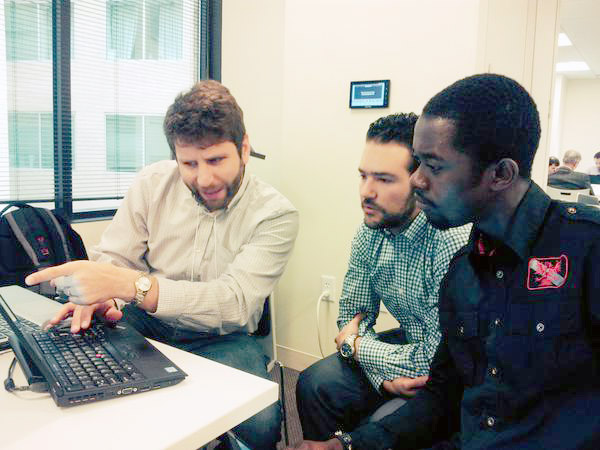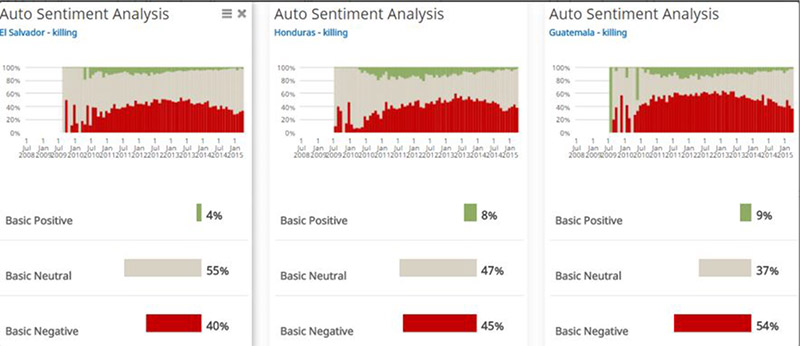
Violent crime in Central America has reached shocking levels. Honduras has the world’s highest homicide rate, while El Salvador and Guatemala are not far behind.
In addition to headline-grabbing murder rates, less visible crimes such as extortion and robbery are commonplace. This makes it difficult to start and run businesses or save for the future, deepening the traps of unemployment and poverty that feed violence. Challenges with the justice and security systems have led to widespread mistrust of these institutions.
USAID missions in the Northern Triangle region (El Salvador, Guatemala y Honduras) have prioritized crime and violence prevention and reduction in their country development cooperation strategies.
Un holístico, data-driven understanding of the security situation is part of the solution. What drives violence? How does the public perceive it? Which solutions have worked in the past, and which are most likely to work in the future?
Afortunadamente, techies and technical experts have the power to bring data-driven interventions to bear on some of Central America’s toughest crime and violence challenges.
An open data hackathon to fight crime

At a recent USAID Latin American and Caribbean Open Data Hackathon 2015 al Centro OpenGov en washington, CORRIENTE CONTINUA., from April 30 a mayo 1, I joined crime and violence experts, application developers, mapping specialists, web designers and others to see how open data could be a better tool in the fight to stem crime and violence.
Our goal was to examine USAID funding flows around the issue of crime and violence to:
- Identify the information USAID has collected and shared publicly;
- Determine how it compares and is supported by high quality, open datasets such as AmericasBarometer;
- Indicate which additional datasets are needed to improve policy and programmatic decision-making.
Our end goal was to create models to combine these datasets and inform USAID on how to best utilize historical data from more than 50 years of programming and improve current data collection and sharing for future programs.
Putting tech to many tasks
At the Hackathon, participants were divided into eight groups to create and test new tech tools to tackle various challenges involving crime and violence. The innovations emerging from the Hackathon were diverse, ranging from analyses of real estate pricing and violence levels to real time tracking of Tweets to chart crime in at-risk areas.
With constantly evolving technology and more and more open data, the opportunities to use data to prevent and reduce crime and violence are enormous. Crime and violence prevention and reduction projects, local leaders and law enforcement could use real time data to track crime in their neighborhoods and devise plans on a daily basis to address them and prevent future incidents.
With access to real time data, responders can easily divide communities into smaller geographic regions to more effectively track emerging trends and respond to crime patterns. Citizens and community-based organizations can also track crime patterns and map out resources available to those affected.
Emerging real time data collection and storage also empowers authorities and citizens to collect and share real time information and intelligence that can help deter, detect and potentially disrupt the planning and execution of crimes and violence.
Twitter to track desensitization to violence
Research on social media conversations about violent crime in Mexico has shown that as violence has increased since 2010, social media commentary has shown signs of desensitization to violence among affected populations. The overall Twitter conversation in these communities has become more emotionally neutral. People are expressing anger at the situation rather than shock or grief.
Is the same thing happening in Central America?
As a member of the Public Opinion and Social Media Data Group at the Hackathon, I worked to track down Twitter posts using a series of keyword searches focused on topics of interest including: homicidio, kidnapping, extorsión, drugs and the names of well-known gangs in the region. By analyzing the posts, we hoped to find the relationship between violence, crime and desensitization.
The platforms we used automatically annotate each post with a URL, author name, ubicación, number of people following and followed, género (inferred from first name if available) and sentiment category: positive, negative or neutral.
Simple sentiment analysis on a homicide-related social media search for El Salvador, Honduras and Guatemala using Crimson Hexagon, a social data analysis platform, produced the following:

En los tres países, the amount of Twitter traffic since 2008 has increased exponentially, but the fraction of both positive and negative sentiment has declined since around 2011.
What is changing? Are Central Americans becoming indifferent to or un-phased by climbing levels of violence? Is violence all too normal an occurrence in their lives? Does other data show the same trends?
Analyzing this type of data adds another level of insight into the psychosocial effects of sustained high levels of crime and violence on individuals and communities. It can help us examine behaviors, motivations and reactions around crime and violence, which may prove useful for designing effective programs.
In addition to exploring sentiment and reactions to local crimes, we can also use social media analysis tools to asses to what degree people are discussing violence and crime in their own country vs. neighboring countries and how the dialogue might change as crime and violence patterns shift.
The way forward for open data solutions
I believe that these kinds of engagements like the Hackathon will help USAID and partners like Creative to look at its funding flows and target the issue of crime and violence. This can help boost USAID missions’ capacity in Latin America in order to make informed decision as they implement prevention and reduction programs in the region.
Methodological rigor in crime and violence prevention and reduction initiatives has increased significantly in the last two decades due in part to more partnership between communities and organizations using relevant real time data as and more user-friendly analytic software programs, from geographic information systems to social media analysis.
We can now produce data and maps depicting crime and violence «hot spots» and conduct spatial analyses that suggest relationships between crime and people’s perceptions towards crime in their communities, as well as the characteristics of the social and physical environments where crime is concentrated.
In the next few decades, I expect to see donor organizations like USAID and its partners follow suit with the White House’s Open Data Policy and make data public, accessible, fully documented, reusable, complete, timely and updated so that it is fully discoverable and usable by others.
This open data revolution will bring even more opportunities to develop and implement data-drive solutions in efforts to improve citizen security. This is just the beginning of how real time data can be used to stem violence in Central America and other parts of the world as technology and citizens join forces to make communities safer.
For those in interested in open data to prevent and reduce crime and violence, sign up for USAID’s open data communications listserv aquí.
Hacer clic aquí to read more about innovations from LacHackathon 2015.
Luther Jeke is an Atlas Corps Service Fellow on the Technology for Development team at Creative Associates International. Antes de unirse a Creative, Luther se desempeñó como Director de Capacitación en iLab Liberia.